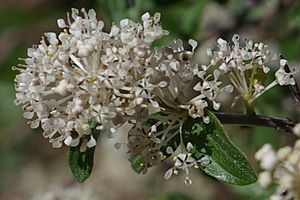Fendler's ceanothus facts for kids
Quick facts for kids Fendler's ceanothus |
|
|---|---|
 |
|
| Scientific classification | |
| Genus: |
Ceanothus
|
| Species: |
fendleri
|
Ceanothus fendleri is a cool plant, a type of shrub often called Fendler's ceanothus or Fendler's buckbrush. It grows naturally in places like northern Mexico, Arizona, New Mexico, and parts of Texas, Utah, Colorado, Wyoming, and South Dakota. You'll usually find it in pine forests, especially in mountains, from about 1,500 to 3,000 meters (around 4,900 to 9,800 feet) high.
Contents
What Does Fendler's Ceanothus Look Like?
Fendler's ceanothus is usually a small shrub, rarely growing taller than 1 meter (about 3 feet).
Stems and Leaves
When the stems and twigs are young, they are grayish-green. As they get older, they turn reddish-brown. This plant has sharp spines up to 2.5 centimeters (about 1 inch) long. Its leaves are thick and grayish-green. If you look at the underside of the leaves, you'll see they are covered with dense, woolly hair.
Flowers
The flowers of Fendler's ceanothus are tiny, about 2 millimeters across, and white. They grow in thick clusters, especially on the older stems, coming out from where the leaves meet the stem. All the flowers open at the same time, making the plant look like it's covered in white blooms. This usually happens in June or July, but it can be any time from April to October, depending on how high up the plant is and what the weather is like. Like other plants in the Ceanothus family, its flowers have five spoon-shaped petals. Each petal partly covers a stamen, which is the part of the flower that produces pollen.
Fruits and Seeds
The fruits are small, pink, and shiny capsules with three sections. They look like a rounded triangle with the stem in the middle. These fruits usually ripen in August and September. When they dry out, these pods burst open with a pop, throwing the seeds out forcefully. This is called explosive dehiscence. The seeds are glossy dark brown and about 2 millimeters across.
Animals and Fendler's Ceanothus
Many animals enjoy eating Fendler's ceanothus.
Deer and Other Animals
Mule deer especially love to browse on this plant. One study in Arizona showed that it was an important food source for mule deer all year round. It made up almost 7% of their summer diet and could be even more important if other food plants are scarce. Other animals like elk, North American porcupines, jackrabbits, and even livestock also eat it, but not as much as deer do.
Insects
The caterpillars of a butterfly called the buckthorn duskywing (Erynnis pacuvius) also feed on Fendler's ceanothus, as well as other plants in the Ceanothus family.
Traditional Uses of Fendler's Ceanothus
Native American people have used Fendler's ceanothus in different ways for a long time.
- Some people have dried the leaves to use as a substitute for tea.
- The Acoma and Laguna Pueblo people ate the fruits of this plant.
- The Navajos mixed this shrub with green gentian to create a special medicine. They used this medicine both inside and outside the body to help with "alarm and nervousness."

